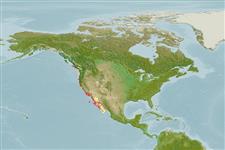>
Atheriniformes (Silversides) >
Atherinopsidae (Neotropical silversides) > Atherinopsinae
Etymology: Atherinops: Greek, atherina, the Greek name for the eperlane; 1770 + Greek, ops = appearance (Ref. 45335); affinis: affinis which means related - in this case to fishes of the genus Atherina (Ref. 6885).
More on author: Ayres.
Environment: milieu / climate zone / depth range / distribution range
Ecología
marino; salobre; rango de profundidad ? - 26 m (Ref. 96339). Subtropical; 52°N - 21°N, 130°W - 105°W (Ref. 96339)
Eastern Pacific: Vancouver Island in British Columbia, Canada to Baja California, Mexico and the Gulf of California.
Tamaño / Peso / Age
Maturity: Lm ? range ? - ? cm
Max length : 37.0 cm TL macho / no sexado; (Ref. 9273); common length : 28.0 cm TL macho / no sexado; (Ref. 9273); edad máxima reportada: 9 años (Ref. 72477)
Espinas dorsales (total): 6 - 10; Radios blandos dorsales (total): 8-14; Espinas anales 1; Radios blandos anales: 19 - 25; Vértebra: 44 - 52. Blue gray to green above, silvery below; a striking silver band bordered above with blue extends the full length of the body (Ref. 6885). Branchiostegal rays: 5-6 (Ref. 36497).
Common in bays, muddy and rocky areas and kelp beds, also in estuaries (Ref. 36497). Form schools. Adults feed on zooplankton (Ref. 9273), while juveniles feed on algae and kelp fly larvae (Ref. 4930). Demersal spawner in nearshore habitats (Ref. 56049). Oviparous, with planktonic, primarily neustonic larvae (Ref. 36497). Eggs are attached to spawning substrate and to one another by adhesive filaments (Ref. 36497).
Eschmeyer, W.N., E.S. Herald and H. Hammann, 1983. A field guide to Pacific coast fishes of North America. Boston (MA, USA): Houghton Mifflin Company. xii+336 p. (Ref. 2850)
IUCN Red List Status (Ref. 130435)
Threat to humans
Harmless
Human uses
Pesquerías: comercial
Más información
ReferenciasAcuiculturaPerfil de acuiculturaRazasGenéticaElectrophoresesheritabilidadEnfermedadesProcesamientoNutrientsMass conversion
Herramientas
Special reports
Download XML
Fuentes de Internet
Estimates based on models
Preferred temperature (Ref.
123201): 12.1 - 23.2, mean 18.7 °C (based on 122 cells).
Phylogenetic diversity index (Ref.
82804): PD
50 = 1.0000 [Uniqueness, from 0.5 = low to 2.0 = high].
Bayesian length-weight: a=0.00912 (0.00491 - 0.01692), b=2.96 (2.79 - 3.13), in cm total length, based on LWR estimates for this species & (Sub)family-body (Ref.
93245).
Nivel trófico (Ref.
69278): 2.8 ±0.28 se; based on food items.
Resiliencia (Ref.
120179): Medio, población duplicada en un tiempo mínimo de 1.4-4.4 años (tm=2; tmax=7; Fec = 1,000).
Fishing Vulnerability (Ref.
59153): Low to moderate vulnerability (27 of 100).
